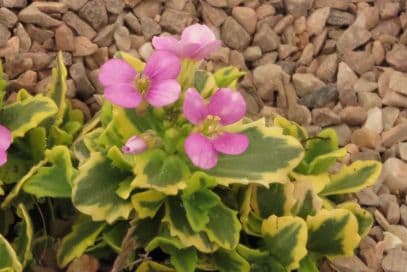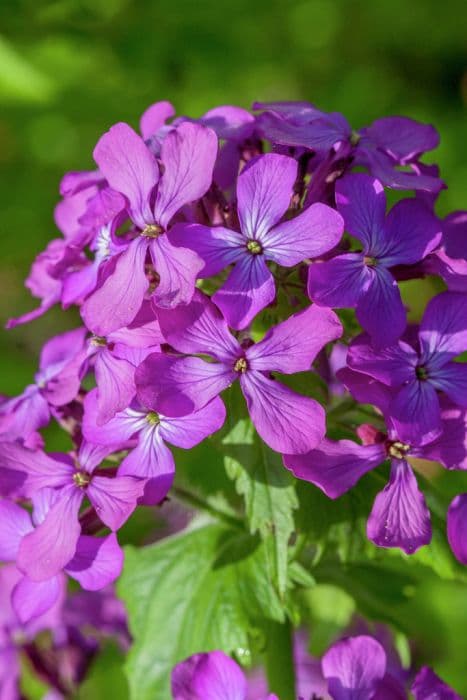Stock Matthiola incana

ABOUT
Matthiola incana, also known as stock or garden stock, is a popular garden plant cherished for its delightful fragrance and attractive flowers. The plant features a lush, grey-green foliage that acts as a backdrop to the primary attraction: its dense clusters of flowers. These blossoms come in an array of colors, ranging from white, pink, mauve, to rich purples and even reds. The flowers are typically double or single and carry a delightful, spicy-sweet fragrance that often intensifies in the evening. The overall shape of the plant is somewhat bushy, with a profusion of narrow, lance-shaped leaves that envelope the sturdy stems. The overall appearance is one of rustic charm blended with a cottage garden aesthetic, making it a favorite for ornamental displays and as a cut flower for indoor enjoyment.
About this plant
 Names
NamesFamily
Brassicaceae
Synonyms
Stock, Hoary Stock, Tenweeks Stock, Gillyflower
Common names
Cheiranthus annuus, Cheiranthus incanus, Matthiola aspera, Matthiola bicornis, Matthiola glaberrima, Matthiola incana subsp. incana, Matthiola incana var. incana, Matthiola longipetala, Matthiola sinuata, Matthiola tricuspidata.
 Toxicity
ToxicityTo humans
Stock is not known to be highly toxic to humans. However, like many plants, it might cause mild irritation or an allergic reaction in some individuals if ingested or if sensitive skin comes into contact with it. There are no severe symptoms of poisoning associated with Stock typically reported.
To pets
Stock is also not considered highly toxic to pets. Ingesting this plant may cause mild gastrointestinal upset in some animals, such as vomiting or diarrhea, particularly if consumed in large quantities. It's always prudent to discourage pets from eating ornamental plants, regardless of their toxicity level, to avoid any potential digestive issues or adverse reactions.
 Characteristics
CharacteristicsLife cycle
Biennials
Foliage type
Evergreen
Color of leaves
Grey-green
Flower color
Varies
Height
1 foot 8 inches (50 cm)
Spread
1 foot (30 cm)
Plant type
Herb
Hardiness zones
7
Native area
Mediterranean
Benefits
 General Benefits
General Benefits- Aesthetic Appeal: Matthiola incana, commonly known as stock, adds color and visual interest to gardens with its range of hues including pink, purple, red, and white.
- Fragrance: Stock is well-known for its sweet and spicy fragrance, which can enhance the sensory experience of a garden.
- Cut Flowers: The flowers of Matthiola incana make excellent cut flowers due to their long vase life and pleasant scent, ideal for floral arrangements.
- Evening Bloomer: Stock's flowers often open in the late afternoon or evening, adding a unique aspect to its appeal in the garden landscape.
- Attracts Pollinators: This plant is attractive to pollinators like bees and butterflies, helping to promote biodiversity in the garden.
- Seasonal Color: Matthiola incana can provide seasonal color in spring and fall, making it a versatile choice for gardeners looking to maintain continual bloom cycles.
- Easy to Grow: Stock is relatively easy to cultivate and can be grown from seeds, making it accessible for gardeners of all skill levels.
- Versatility: It can be grown in borders, beds, or containers, offering flexibility in garden design and space utilization.
- Edging Plant: Due to its shape and size, stock can be used as an edging plant, providing structure and bordering for garden paths or other plantings.
 Medical Properties
Medical Properties- This plant is not used for medical purposes
 Air-purifying Qualities
Air-purifying QualitiesThis plant is not specifically known for air purifying qualities.
 Other Uses
Other Uses- Matthiola incana, commonly known as stock, can be used as a natural dye source. The flowers and leaves of stocks can produce dyes for textiles, yielding a range of colors depending on the mordant used.
- Stock flowers are edible and can add a decorative touch to salads and desserts with their mild, slightly peppery flavor.
- In perfumery, the sweet and floral fragrance of stock is sometimes used in creating scents and aromatherapy products, adding a touch of garden freshness.
- The plant can be used as a decorative element in floral art and pressing due to its colorful and structured flowers, perfect for crafts.
- Stocks can serve as companion plants in the garden, attracting beneficial insects like bees and butterflies while deterring some pests.
- The flowers are traditionally incorporated into wedding bouquets and arrangements to symbolize lasting beauty and a happy life.
- Stock flowers can be used as a natural moth repellent when dried and placed in clothes storage areas.
- Some cultures use stock as a part of ritualistic or ceremonial practices, appreciating its fragrance and symbolism.
- The dense and upright growth habit of Matthiola incana makes it a suitable plant for creating garden borders and formal bed designs.
- When planted in mass, stock can be used to create a visually striking living backdrop for garden parties and outdoor events.
Interesting Facts
 Feng Shui
Feng ShuiThe Stock flower is not used in Feng Shui practice.
 Zodiac Sign Compitability
Zodiac Sign CompitabilityThe Stock flower is not used in astrology practice.
 Plant Symbolism
Plant Symbolism- Lasting Beauty: Matthiola incana, commonly known as stock, symbolizes enduring beauty due to its pleasant fragrance and long-lasting blooms.
- Happy Life: Stocks are often associated with a happy life, and they are given to wish someone a fulfilling and joyous existence.
- Bonds of Affection: The plant represents the strong bonds of affection and is frequently used to signify the unbreakable connections between loved ones.
- Contentment: Stock flowers imply contentment, reflecting the serene and satisfied aspects of one's life.
- Promptness: Historically, these flowers were associated with promptness, possibly derived from their swift growth.
 Water
WaterStock (Matthiola incana) prefers consistent moisture but does not like to be waterlogged. During the growing season, water the plant deeply once or twice a week, depending on weather conditions and soil drainage. Allow the top inch of soil to dry out between waterings. The amount of water needed can vary, but a good rule of thumb is approximately half a gallon per square foot every week. Be cautious to water at the base of the plant to avoid wetting the foliage, which can lead to fungal diseases.
 Light
LightStock thrives in full sun to partial shade, with at least 4 to 6 hours of direct sunlight per day. It is best to place the plant in a location where it can receive ample morning sunshine while being protected from the intense heat of the afternoon sun.
 Temperature
TemperatureStock plants do well in a temperature range between 55°F and 65°F, which promotes healthy growth and flowering. They can tolerate temperatures down to about 20°F but will be damaged by a hard frost. Protecting the plants from extreme heat is also important, as temperatures above 75°F can stress the plant.
 Pruning
PruningPruning stock plants involves deadheading spent flowers to encourage additional blooming and to maintain a tidy appearance. Prune the plant regularly throughout the flowering season by removing the old flower heads. The best time for pruning is when the flowers fade.
 Cleaning
CleaningAs needed
 Soil
SoilStock prefers well-draining soil with a pH range of 6.0 to 7.5; a mix of loam, compost, and sand is ideal to foster healthy growth.
 Repotting
RepottingStock (Matthiola incana) generally does not need frequent repotting; it's best to repot annually or when it becomes root-bound.
 Humidity & Misting
Humidity & MistingStock thrives in moderate humidity levels but is quite adaptable and can tolerate dry air.
 Suitable locations
Suitable locationsIndoor
Place Stock in a sunny spot and ensure good air circulation indoors.
Outdoor
Plant Stock in a sunny location with well-draining soil.
Hardiness zone
7-10 USDA
 Life cycle
Life cycleMatthiola incana, commonly known as Stock, begins its life cycle as a seed that germinates in cool temperatures, typically in early spring or late winter. Upon germination, it develops a rosette of leaves at the ground level. As temperatures warm, the plant enters the vegetative stage, producing a taller stem and more foliage. During the flowering stage, usually in late spring to summer, Stock produces fragrant blossoms in clusters that can come in a variety of colors including white, pink, red, and purple. After pollination, the flowers develop into fruit capsules that contain seeds, completing the reproductive cycle. The plant then either dies back, if it is an annual or biennial type, or may persist and re-flower in subsequent years if it is grown as a perennial, depending on the climate.
 Propogation
PropogationPropogation time
Spring
Propogation: Stock, commonly referred to as Matthiola incana, is typically propagated from seeds. The most popular method of propagation for stock is by sowing seeds directly into garden soil or starting them indoors before the last frost. When sowing indoors, you should plant the seeds about 1/4 inch (approximately 6 millimeters) deep in soil, using starter trays or small pots. Seeds usually germinate in one to two weeks if kept at a consistent temperature of 65 to 70 degrees Fahrenheit (about 18 to 21 degrees Celsius). Seedlings can be thinned once they develop two true leaves and transplanted outdoors after the risk of frost has passed. It's important to acclimate them to outdoor conditions gradually over several days to reduce transplant shock. This method is favored for its simplicity and effectiveness in producing new plants that are true to the parent's characteristics.









